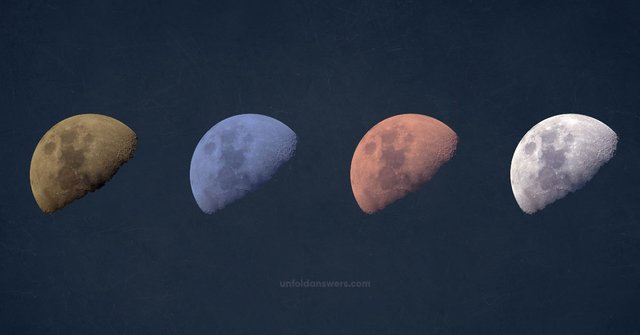What is the color of the moon? – The reason behind colored moon
What is the color of the moon? If you look at the moon, it appears mostly white or yellow, sometimes blue and sometimes red. Does the moon really change colors or it has definite colours?
What is the color of the moon?
Moon is grey because of the abundance of oxygen, silicon, magnesium, iron, calcium, and aluminum on its surface. The other colors that are contained by elements on the surface of the moon, which are not much in proportion are not seen. With different explanations, people say that the moon has various colors but in fact, the color that is more in proportion is just grey and so it looks.
Moon from the Earth
Moon does not have its own light, it just reflects the sunlight. The moon that we are talking about, Earth’s moon is not a good reflector as compared to the other planets or moons as it reflects only around 13 percent of the light that falls on it. We just see it brighter than other planets because of its closeness with the Earth.
The color that we see is just a result of the scattering of light (Rayleigh scattering), same reason due to which sky is blue. The scattering of reflected sunlight can result in different colors of the moon.
The moon appears mostly yellow at night and white during day time as we see from Earth. The yellow color is seen since yellow light is one of less scattered light as the light travels through the atmospheric particles. The red color though scattered least is not seen because yellow is relatively scattered more in proportion with greater abundance. During the day the moon appears white due to excess of sunlight (white light) coming directly from the Sun.
What is the cause of blue and red moon?
The blue and red moon are seen in different circumstances. The blue color of the moon is exceptional while red texture on the yellow moon is often seen. As mentioned earlier, the color is due to scattering of light.
The moon appears blue when the atmospheric particles are of the right size (size close to the wavelength of blue light) to selectively scatter the blue light. This happens mostly in the regions where there is the availability of particles having such size. For instance, aerosols produced from the coniferous plants can react with ozone to give such sized particles. The place with an abundance of coniferous plants is likely to visualize the blue moon.
Similarly, the smokes created by factories and fires can produce particles in the atmosphere with a size close to the wavelength of red light. This produce a dispersion of red light and we can see the red moon due to the abundance of red light. Also, during the rising and setting of the moon, the light coming from the moon has to travel a greater distance in the atmosphere. Due to this the yellow light can get too much scattered from our line of sight with red light only remaining. So, the moon can appear red in such circumstances.
Blue moon – Once in a blue moon
Blue moon, this phrase is often referred to the moon which is not actually blue to see but a rare moon. Each year offers usually 12 full moons and each full moon occurs in every 29 and half days. So in a year, there are approximately 11 more days. That means in three years an extra moon can occur. This moon is called ‘the blue moon’.
The 12 full moons occur with 3 in each of four seasons in a year. But, during the occurrence of 13 full moons in a year, a season out of four has an extra full moon i.e. total four full moons. So generally one of the moons in a season with four moons is called a blue moon.
Moon from space
Space does not have any particles to scatter the light coming from the moon so we see only color i.e. grey. The appearance of moon is the representation of the minerals that make it up.
Source - Unfoldanswers.com
